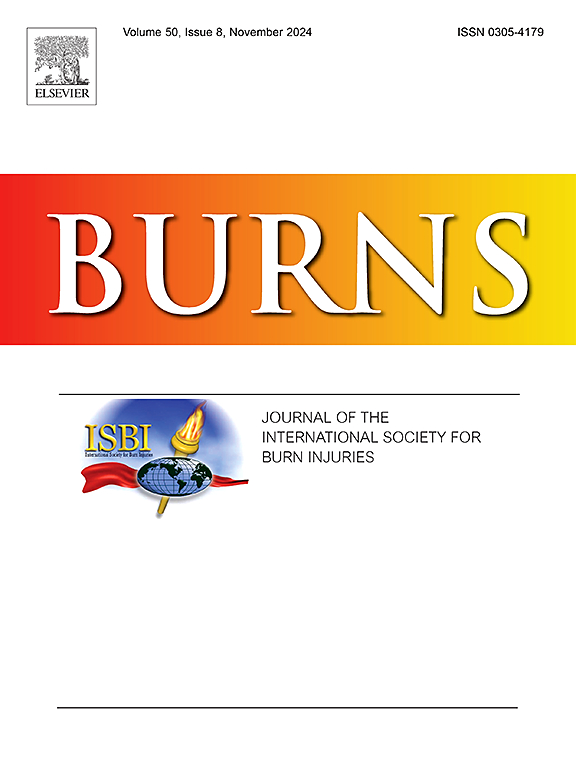Identification and validation of immune-related biomarkers and polarization types of macrophages in keloid based on bulk RNA-seq and single-cell RNA-seq analysis
IF 3.2
3区 医学
Q2 CRITICAL CARE MEDICINE
引用次数: 0
Abstract
Introduction
Keloids are a common complication that occurs after injury. The pathogenesis of this disease remains unknown. Therefore, identifying immune-related biomarkers and macrophage polarization types in keloids can provide new insights into their treatment.
Methods
In this study, keloid-related bulk RNA-seq data (GSE83286, GSE212954, GSE92566, and GSE90051) were obtained from the Gene Expression Omnibus (GEO) database. The datasets GSE83286, GSE212964, and GSE92566 were combined to form a training set, while GSE90051 was utilized as an external validation set. Differentially expressed genes (DEGs) were detected by comparing keloid and normal samples within the training set. Differentially expressed immune-related genes (DIRGs) were then determined by intersecting the DEGs with immune-related genes (IRGs). Based on the protein-protein interaction (PPI) network, the top 40 DIRGs were selected for further analyses. Weighted Gene Co-expression Network Analysis (WGCNA), in conjunction with three machine learning techniques - least absolute shrinkage and selection operator (LASSO), support vector machine-recursive feature elimination (SVM-RFE), and random forest (RF) - employed to identify biomarkers. Subsequently, a nomogram model was constructed and validated. Single-cell RNA (scRNA) analysis was used to examine the expression of biomarkers at the cell-type level. Furthermore, since keloid is a chronic inflammatory disease and the abnormal polarization of macrophages is essential for the occurrence of this kind of disease, in this study we also endeavor to elucidate the state of macrophage polarization dysregulation within keloid, with the anticipation of generating novel concepts for the treatment of keloid. Finally, western blot (WB) and immunofluorescence (IF) analyses were carried out to confirm the expression levels of the biomarkers.
Results
A total of 740 DEGs were identified in the training set, comprising 331 up-regulated genes and 409 down-regulated genes. After intersecting with the IRGs, 73 DIRGs were obtained. Subsequently, the top 40 DIRGs were chosen for further analysis. Eventually, two biomarkers, namely BMP1 and IL1R1, were identified through WGCNA and the three machine learning methods. Their expression levels were then verified by single-cell analysis, WB, and IF analysis. Additionally, it was found that the number of M2 macrophages significantly increased, while the number of M1 macrophages decreased in keloids compared to normal samples.
Conclusion
BMP1 and IL1R1 might function as novel biomarkers and potential therapeutic targets for keloid treatment. Moreover, upregulating M1 macrophages and downregulating M2 macrophages could represent a promising approach for the treatment of keloids.
基于整体RNA-seq和单细胞RNA-seq分析的瘢痕疙瘩中免疫相关生物标志物和巨噬细胞极化类型的鉴定和验证
瘢痕疙瘩是损伤后常见的并发症。这种疾病的发病机制尚不清楚。因此,识别瘢痕疙瘩中的免疫相关生物标志物和巨噬细胞极化类型可以为其治疗提供新的见解。方法本研究从Gene Expression Omnibus (GEO)数据库中获取瘢痕疙瘩相关的大量RNA-seq数据(GSE83286、GSE212954、GSE92566和GSE90051)。将数据集GSE83286、GSE212964、GSE92566合并为训练集,使用GSE90051作为外部验证集。通过比较训练集中瘢痕疙瘩和正常样本来检测差异表达基因(DEGs)。然后通过将差异表达的免疫相关基因(DIRGs)与免疫相关基因(IRGs)相交来测定差异表达的免疫相关基因(DIRGs)。基于蛋白质相互作用(PPI)网络,选择了排名前40位的dirg进行进一步分析。加权基因共表达网络分析(WGCNA),结合三种机器学习技术-最小绝对收缩和选择算子(LASSO),支持向量机递归特征消除(SVM-RFE)和随机森林(RF) -用于识别生物标志物。随后,构建了nomogram模型并进行了验证。单细胞RNA (scRNA)分析用于检测细胞类型水平上生物标志物的表达。此外,由于瘢痕疙瘩是一种慢性炎症性疾病,巨噬细胞的异常极化对这种疾病的发生至关重要,因此在本研究中,我们也将努力阐明瘢痕疙瘩内巨噬细胞极化失调的状态,以期为瘢痕疙瘩的治疗提供新的概念。最后,进行western blot (WB)和免疫荧光(IF)分析,以确认生物标志物的表达水平。结果共鉴定出740个基因,其中上调基因331个,下调基因409个。与irg相交后,得到73个dirg。随后,选取排名前40位的dirg进行进一步分析。最终,通过WGCNA和三种机器学习方法鉴定出两个生物标志物BMP1和IL1R1。然后通过单细胞分析、WB和IF分析验证其表达水平。此外,与正常样本相比,瘢痕疙瘩中M2巨噬细胞数量明显增加,而M1巨噬细胞数量减少。结论bmp1和IL1R1可能是治疗瘢痕疙瘩的新型生物标志物和潜在靶点。此外,上调M1巨噬细胞和下调M2巨噬细胞可能是治疗瘢痕疙瘩的一种有希望的方法。
本文章由计算机程序翻译,如有差异,请以英文原文为准。
求助全文
约1分钟内获得全文
求助全文
来源期刊

Burns
医学-皮肤病学
CiteScore
4.50
自引率
18.50%
发文量
304
审稿时长
72 days
期刊介绍:
Burns aims to foster the exchange of information among all engaged in preventing and treating the effects of burns. The journal focuses on clinical, scientific and social aspects of these injuries and covers the prevention of the injury, the epidemiology of such injuries and all aspects of treatment including development of new techniques and technologies and verification of existing ones. Regular features include clinical and scientific papers, state of the art reviews and descriptions of burn-care in practice.
Topics covered by Burns include: the effects of smoke on man and animals, their tissues and cells; the responses to and treatment of patients and animals with chemical injuries to the skin; the biological and clinical effects of cold injuries; surgical techniques which are, or may be relevant to the treatment of burned patients during the acute or reconstructive phase following injury; well controlled laboratory studies of the effectiveness of anti-microbial agents on infection and new materials on scarring and healing; inflammatory responses to injury, effectiveness of related agents and other compounds used to modify the physiological and cellular responses to the injury; experimental studies of burns and the outcome of burn wound healing; regenerative medicine concerning the skin.
 求助内容:
求助内容: 应助结果提醒方式:
应助结果提醒方式:


